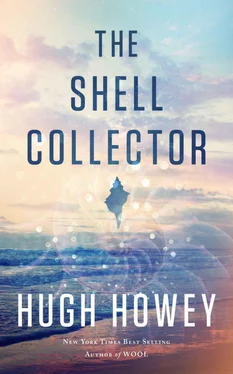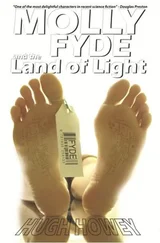Finally, Ness throttles back and the bow dips. The boat slows. We are in a patch of sea that looks like any other on the surface, but I see Ness studying the GPS, which shows our boat as a small triangle on top of a classic symbol for a shipwreck: a curved hull with what might be a sail-less mast but looks more like a cemetery cross.
“I thought you said it was just offshore,” I say. Ness reverses the throttle briefly to kill our speed, then looks back toward land.
“Seven miles,” he says. “Practically on the beach.”
He goes forward to toss out the anchor. I slide over into his spot and study the GPS. The large screen shows the depth of the water in feet. Right by our position, the numbers range from 70 to 120. There’s a steep ridge here. The water is much deeper toward land before rising back up again. If all the oceans were stripped away, these would be rolling hills overlooking a majestic valley. Instead, it’s a world invisible, the contours seen only in a scattering of numbers and covered over by fathoms of blue dirt.
“You said earlier that I shouldn’t dive deeper than sixty feet,” I point out. Maybe it’s the shipwreck symbol or my bout of paranoia earlier, but I have a bad feeling about this plot of sea. Like something awful will happen here.
Ness throws out the anchor and watches as coil after coil of rope zips over the rail. When the line begins to slide away lazily, he cinches it off on a cleat. I remember helping my father do that. It was my job on the boat. Here, I’m an anxious spectator.
“It’s a little over eighty to the bottom,” he says. “You don’t have to go that far. The wreck sits up off the sea floor, so it’s less than sixty down to the conning tower. Besides, there’s not much good shelling this shallow unless you get pretty remote. It’s all been picked over. But you can see the wreck, and if you’re comfortable hanging out for a few minutes at depth, I can show you where I used to make my finds.”
“I thought you’d be with me the whole time.”
“I will. If you don’t feel comfortable, we can come right back up. Just give me this sign.” Ness points straight up. “Do it with both hands, if possible. If you don’t feel like you’re getting air for any reason, do this.” He makes a choking gesture.
“Comforting,” I say.
“And if everything is okay, give the okay sign. If you give me a thumbs-up, I won’t know if you’re doing great or you want to go up to the boat.”
“Sixty feet, ten minutes,” I tell him.
“It’s a guideline,” Ness says. “Don’t worry if you go a little below that or stay down fifteen minutes. It gives you a lot of leeway. We won’t be long, and we’ll come up nice and slow, maybe even make a couple safety stops just to make my dearly departed dive master happy.”
“Whatever’s the safest, that’s what I want to do.”
“Don’t worry. We’ll be perfectly safe. Trust me.”
I try to. He and I drag our duffels to the stern of the boat and begin setting out the gear. There’s a small door on one side of the outboards and a narrow dive platform. I figure out how to work the door, and I kick the stainless steel ladder hinged to the platform into the water. Somehow, effecting my doom lessens the worry. Nerves are like carsickness: I get less nauseated if it’s my hands on the wheel.
Ness starts prepping his tank, and I do the same with mine, repeating the steps I learned just an hour or so ago. I appreciate that he lets me do it myself, but I make sure he’s keeping an eye on me. I assume he’ll tell me if I do anything wrong. When I crack the valve on the tank, there’s a brief sputter of air, and then the rubber gasket catches tight.
“Let’s get your weight belt on,” Ness says, “and then your tank. You can sit on the platform to do your fins and mask.”
I look at the platform. It’s only wide enough for one person at a time.
“I’m not going in first,” I say. This is a statement of fact. Not a complaint. Or question. Or suggestion. To my editor, I would say that this has been properly vetted. It is a true thing . I am not getting in this water, nearly out of sight of land, all alone.
“You’ll be fine. Ladies first, right? I’ll be in right after y—”
“No, not ‘ladies first,’ Ness Wilde. Not ladies first. I am not getting in this ocean before you do. Do you hear me? I’m dead serious.”
Ness studies me for a moment, and I can’t tell how this is going to go down, if we’ll have to take the boat back to the dock, if I’ll have to sit here while he dives alone, if I’ll end up snorkeling, which would be damn fine with me. But then he smiles, and it feels like the most genuine smile I’ve seen from him. The happiest I’ve seen him. Me telling him he’s dead wrong about this me-getting-in-the-water-first business that he’s suggesting.
“Okay. We’ll get you situated on the dive platform, and I’ll go over the side. We’ll make it work. I’ll be in the water waiting for you.”
I barely hear what he’s saying. It takes a moment to process. But my pulse eventually stops pounding in my ears, and the sun doesn’t beat down quite so hard. I realize I’m sweating inside my wetsuit, which is soaking up the summer morning heat. I finally nod and agree to his plan. He helps me cinch the heavy weight belt around my waist, then lifts my BC, and I get my arms through, do the buckles myself. Ness has me sit on the edge of the swim platform, my legs dangling in the water, and I put my fins on one at a time. I dip my mask in the water, and not wanting to take chances with it fogging, I say screw it and spit on the inside of the lens and rub it around, just like my mom taught me. I dunk the mask again to rinse it and put it on my forehead, then turn to see how Ness is going to get in around me.
He already has his BC on. Balancing on one leg at a time, Ness kicks on each of his fins standing up, the boat rocking gently beneath us. He grabs his mask, tests his air, and then sits on the side of the boat, his back to the water.
“See you in heaven,” he says. And then he rocks back, tipping dangerously, his tank and the back of his head flying toward the water, and I can’t see around the edge of the boat, but there’s a mighty splash, and I’m wondering what in the world he meant and if I can figure out how to crank the boat and get back to the dock by myself, when Ness bobs up by my feet, pulls his regulator out of his mouth, and flashes that famous smile.
“That seemed violent,” I say.
He holds the platform beside my thigh to steady himself. “Don’t try to go in slow,” he says. “You’ll hit your tank on the platform, or you’ll hit your head on the outboard. You want to fall forward. Tuck a little bit and hold your mask to your face with both hands so it doesn’t fall off. Look to the side if that makes you feel better.”
This feels dumb. Like the worst way to get in the water ever. I start to ask if I can’t just turn around and descend the ladder, but I’ve spent enough of my life in fins to understand how poorly that would work. I trust him. Maybe not with anything else, not with the fate of the world, or with the truth, but I trust him in this moment not to get me killed. I fully appreciate the insanity of this paradox, but I accept it anyway. And letting go of the boat, and a decade of fear, and all the thoughts and worries that plague me, and my concern for my mortal coil, and any connection I have with the world above the sea or with the cosmos that sustains me, I tip forward and crash into the Atlantic Ocean, and she wraps me in her soft embrace.
All I see are bubbles—both from the turbulence of my entry and my panicked exhalations. The regulator is half out of my mouth. I wrestle it back in. And then the buoyancy of my suit and my frantic kicking and remembering what Ness taught me by the dock about bubbles going up —and I break the surface, sputtering and cursing and spitting out my regulator to take in huge gulps of air.
Читать дальше












